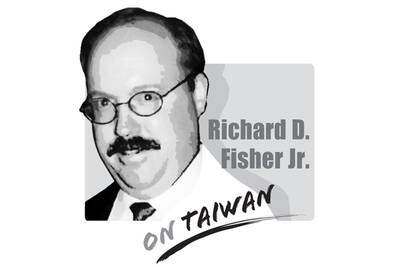Long before Sunday’s debate on the proposed economic cooperation framework agreement (ECFA) with China, President Ma Ying-jeou (馬英九) argued that Taiwan cannot afford to be left out of increasing regional economic integration. Ma has made it clear that free-trade agreements (FTA) are a positive trend and that an ECFA would serve as a bridge with the region as ASEAN Plus One (China) and ASEAN Plus Three (China, Japan and South Korea) come into force.
The actual impact of FTAs with China on smaller regional economies, however, is only beginning to be understood. Still, early signs show that it might be wise to adopt a careful “go slow” approach.
A mere four months after ASEAN Plus One came into force, an FTA between six founding members of the organization and China, some sectors — such as textiles and garments, tires, steel and footwear — are already suffering in countries such as Indonesia, one of the signatories. Some garment factories in Jakarta have already gone under as a result of the flood of cheap Chinese clothing that have poured into the country. In some cases, the new competition drove down prices to such an extent that local companies were forced to sell jackets for less than they cost to make.
The chairman of Indonesia’s National Workers Union has said the trade deal could cost as many as 7 million jobs.
Representatives of the sectors that are at risk from the trade pact have called on Jakarta to renegotiate some aspects of the FTA or slow down the lowering of tariffs on certain products, calls the Indonesian government appears reluctant to act upon.
Still, if pressure from workers in Southeast Asian countries becomes strong enough as the negative effects of the asymmetrical FTA become more apparent, those governments may be compelled to turn to Beijing and ask for remedial measures. In the name of good relations and to protect its long-term trade interests, it is not impossible that Beijing would show some willingness to accommodate its smaller partners. The key reason is that all the members of ASEAN Plus One and ASEAN Plus Three are sovereign countries recognized by Beijing.
When it comes to Taiwan, however, an ECFA — which appears to be intended as a first step in the gradual implementation of a full-blown FTA — is not being negotiated between two sovereign states, since Beijing does not recognize Taiwan.
The long-term implications are worrying. Even if, as Ma has promised, short-term measures are implemented to mitigate the negative impact of an ECFA on vulnerable sectors of the economy and even if Beijing makes initial concessions on the “early harvest” list, China is far less likely to show flexibility over time. This is largely because it will look at that discontent and address it as a domestic problem rather than one between states. In other words, the mechanisms that normally apply to FTAs between sovereign states will not do so when it comes to Taiwan. Consequently, Beijing is expected to be far less amenable to renegotiation or goodwill once the pact has been signed, especially in light of cross-strait liberalization as a means to accelerate its unification strategy.
An ECFA will not solve every problem arising from regional economic liberalization and will undoubtedly create new ones. Although Ma prefers to address the matter as if it were purely a question of economics, the fact the two negotiating entities are engaged in an asymmetrical relationship economically and politically means that resolving those challenges will be all the more difficult.
Factory workers in ASEAN countries have difficult times ahead of them, but this could be far less onerous than the nightmare that Taiwanese workers in similar sectors could face five or 10 years from now.

As the Chinese Communist Party (CCP) and its People’s Liberation Army (PLA) reach the point of confidence that they can start and win a war to destroy the democratic culture on Taiwan, any future decision to do so may likely be directly affected by the CCP’s ability to promote wars on the Korean Peninsula, in Europe, or, as most recently, on the Indian subcontinent. It stands to reason that the Trump Administration’s success early on May 10 to convince India and Pakistan to deescalate their four-day conventional military conflict, assessed to be close to a nuclear weapons exchange, also served to

The recent aerial clash between Pakistan and India offers a glimpse of how China is narrowing the gap in military airpower with the US. It is a warning not just for Washington, but for Taipei, too. Claims from both sides remain contested, but a broader picture is emerging among experts who track China’s air force and fighter jet development: Beijing’s defense systems are growing increasingly credible. Pakistan said its deployment of Chinese-manufactured J-10C fighters downed multiple Indian aircraft, although New Delhi denies this. There are caveats: Even if Islamabad’s claims are accurate, Beijing’s equipment does not offer a direct comparison
After India’s punitive precision strikes targeting what New Delhi called nine terrorist sites inside Pakistan, reactions poured in from governments around the world. The Ministry of Foreign Affairs (MOFA) issued a statement on May 10, opposing terrorism and expressing concern about the growing tensions between India and Pakistan. The statement noticeably expressed support for the Indian government’s right to maintain its national security and act against terrorists. The ministry said that it “works closely with democratic partners worldwide in staunch opposition to international terrorism” and expressed “firm support for all legitimate and necessary actions taken by the government of India
Taiwan aims to elevate its strategic position in supply chains by becoming an artificial intelligence (AI) hub for Nvidia Corp, providing everything from advanced chips and components to servers, in an attempt to edge out its closest rival in the region, South Korea. Taiwan’s importance in the AI ecosystem was clearly reflected in three major announcements Nvidia made during this year’s Computex trade show in Taipei. First, the US company’s number of partners in Taiwan would surge to 122 this year, from 34 last year, according to a slide shown during CEO Jensen Huang’s (黃仁勳) keynote speech on Monday last week.